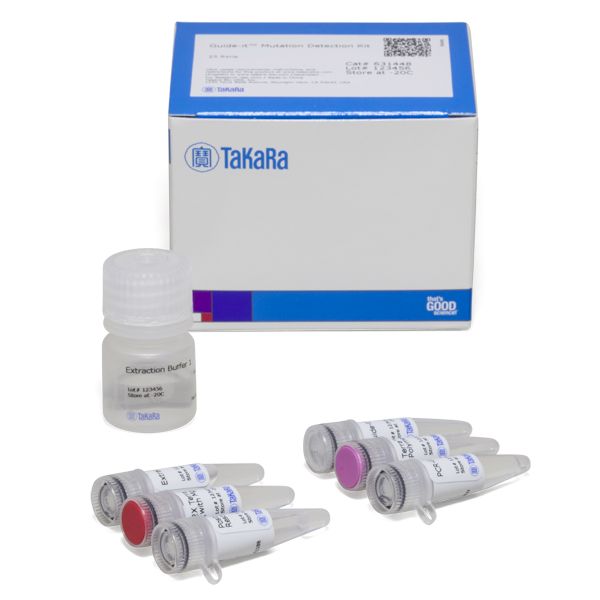Guide-it Mutation Detection Kit
Guide-it Mutation Detection Kit
Simple method to identify insertions or deletions in mammalian cells
The Guide-it Mutation Detection Kit contains all the reagents needed for PCR-based identification of insertions or deletions generated during cellular non-homologous end joining (NHEJ) repair. The first step is the amplification of the putative target sequence directly from cells. This kit uses Terra PCR Direct Polymerase Mix and Buffer, so there is no need to extract genomic DNA from your cell population prior to amplification of your target sequence. The amplicon is then melted and hybridized to form the mismatched targets for cleavage by the Guide-it Resolvase. Sufficient material is provided for 100 amplification and cleavage reactions.
Overview
- Simple method to identify insertions or deletions in mammalian cells
- Faster and more efficient than the surveyor assay; amplify directly from your target cells
- Complete kit: Guide-it Resolvase, Terra PCR Direct Polymerase, and all buffers included
- Value: 100 reactions per kit; also available in a 25-reaction size for small-scale genome editing projects
- Perfect for confirming sequence changes downstream from Cas9/CRISPR, TALENs, or zinc-finger nuclease studies
Applications
- Confirmation of mutations caused by genome editing technologies, including CRISPR/Cas9, TALENs, or zinc-finger nucleases
- Detecting insertions and deletions in mammalian genomic DNA
The Guide-it Mutation Detection Kit is used to confirm the presence of mutations in genomic DNA

The Guide-it Mutation Detection Kit is used to confirm the presence of mutations in genomic DNA. In the first step your target sequence is amplified directly from your target cells using the Terra PCR Direct Polymerase included in the kit, so there is no need to extract and purify genomic DNA from your cell population prior to amplification of your target sequence. The amplicon is then melted and hybridized to form the mismatched targets that can be cleaved by the Guide-it Resolvase.
Comparison of the Guide-it and Surveyor assays for detecting mutations in mammalian cells

Comparison of the Guide-it and Surveyor assays for detecting mutations in mammalian cells. 293T cells were transfected with plasmids encoding Cas9 and a sgRNA specific for the AAVS1 locus. Transfected cells were harvested 48 hr post-transfection and mixed with untransfected cells at varying ratios. An amplicon containing the targeted AAVS1 locus was generated using Terra Direct Polymerase Mix, and the PCR products were purified and cleaved using either Guide-it Resolvase or the Cel1 enzyme (Surveyor assay). Mutations were easily discernable when using the Guide-it kit. In contrast, the Surveyor Assay showed considerable smearing, making it difficult to determine cleavage efficiency and reducing the ability to detect low levels of mutation.
Successful knockout of AcGFP1 in HT1080 cells using the CRISPR/Cas9 system

Successful knockout of AcGFP1 in HT1080 cells using the CRISPR/Cas9 system. Panel A. Schematic of the AcGFP DNA sequence and the location of sgRNAs tested and primer placement for the mutation detection assay. HT1080 cells containing a single copy of AcGFP1 were transfected with 1.5 μg of plasmid DNA for Cas9 expression and 1.5 μg of a plasmid harboring one of two sgRNAs (T1 or T2) using Xfect Transfection Reagent. The cell population was assayed 6 days post-transfection for cleavage efficiency and loss of fluorescence. Panel B. Using the Guide-it Mutation Detection Kit, cleavage products were detected for both sgRNAs, indicating that both CRISPRs successfully disrupted the AcGFP1 locus. Panel C. The AcGFP1 disruptions were functionally relevant, as a subpopulation of non-fluorescent cells could be detected by FACS.


